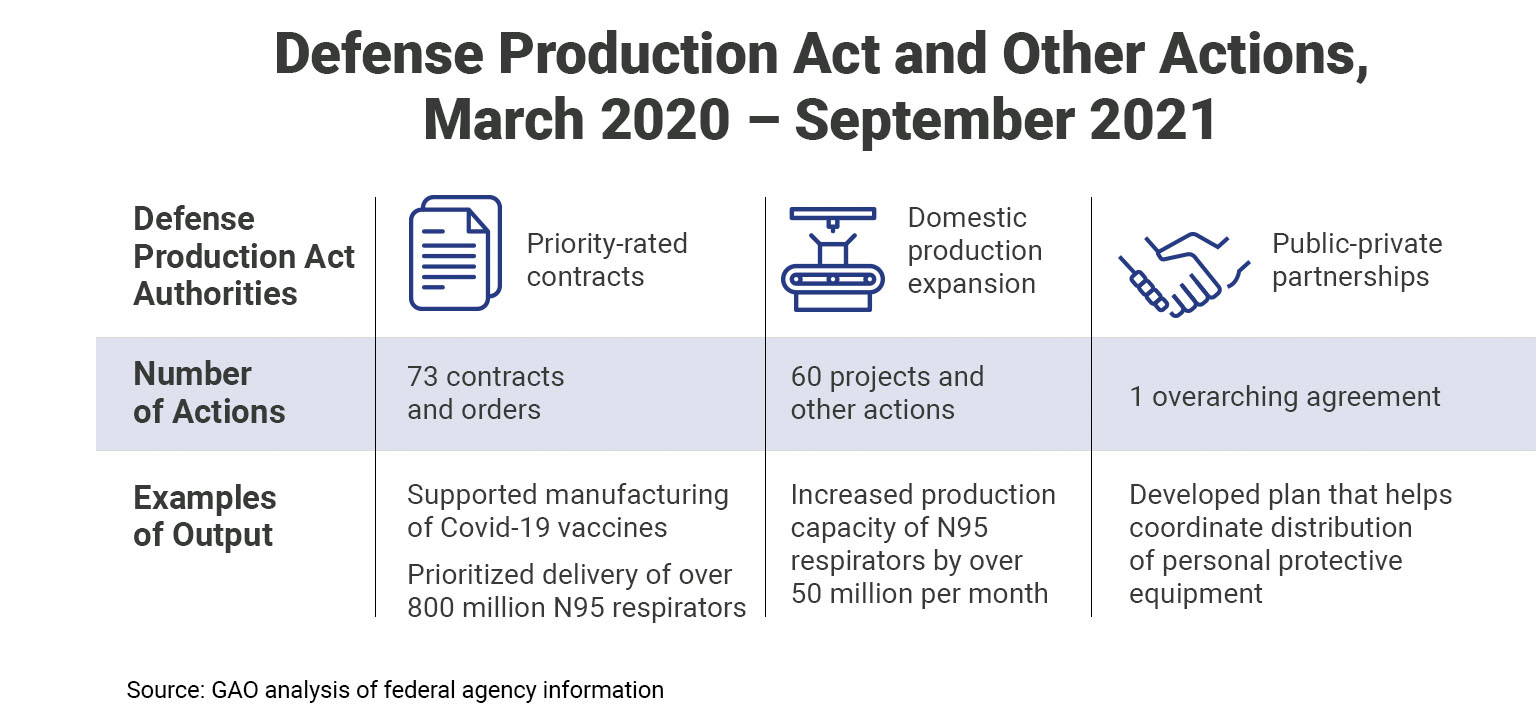
Preparing for the Next Pandemic With DPA Title III
Health Policy Transformation, Pandemic Response Support, Disaster Preparedness, Health
Both Presidents Trump and Biden invoked Title III of the Defense Production Act (DPA) in response to the COVID-19 pandemic, enabling the federal government to infuse capital into domestic companies that could provide critical medical resources. Now that the COVID-19 pandemic has led to increased awareness and use of DPA Title III, there is an open question of when and how often agencies should rely on this authority in the future.
Throughout the pandemic, the DPA Title III program office within the Department of Defense (DoD) has supported other agencies tasked with pandemic response, including the Department of Health and Human Services (HHS). According to a recent Government Accountability Office (GAO) report examining the effectiveness of using DPA during the pandemic, federal agencies used DPA and other emergency actions more than 100 times to help manage medical supply needs, prioritize contracts, and fund projects.

The American Rescue Plan funded an additional $10 billion through 2025 for projects and contracts via DPA as the government continues its pandemic response. Yet, DPA Title III was never meant to be the sole or permanent solution to ongoing pandemic preparedness. It is time to consider how best to continue tapping into the expertise and resources of DPA while developing new tools as part of broader pandemic preparedness efforts.
Preparing for the Next Pandemic
While DPA Title III was helpful during the COVID-19 response efforts, the long-term goal is not to use DPA Title III in all cases of urgent need. Agencies are formalizing their own efforts to create a better understanding of when and where to use DPA Title III, and what other authorities exist in the federal government to provide more strategic emergency response planning. HHS recently announced an effort to maintain a permanent DPA Title III office to coordinate the funding of projects and contracts. While this is a positive development and one recommended in the GAO’s report, it is not enough.
Brennan Grignon, an independent consultant working with LMI, supported acquisition efforts between DoD and HHS during the pandemic and notes that more permanent efforts are needed. “Pandemic preparedness—or preparing for any emergency—is more complex than establishing the ability to exercise a single authority like DPA Title III,” she says. “Federal agencies need to understand the entire spectrum of authorities and laws enabling a whole-of-government response to an emergency like COVID-19. From a supply chain perspective, agencies must better understand the role of commercial companies, both domestic and foreign, in their supply chains in order to conduct proactive and strategic preparedness and response planning.”
Dr. George Karpin, senior consultant at LMI, agrees. He notes that a key function of DPA Title III has been engaging the nation’s private sector to change its production capabilities on a temporary basis to produce supplies for vaccines or test kits in the U.S. while the global supply chain is under duress. A similar problem is likely to occur in future pandemics, and those efforts can provide a roadmap for how to support a more resilient onshore supply chain. Government and the private sector must work together continuously to maintain those capabilities and share information.
“We have information now about what it takes to get certain supplies locally and how much of them we might need,” says Dr. Karpin. “For example, when we talk about producing vaccines, we aren’t just talking about what’s in the vial, we’re talking about the vials themselves. We had to get all of the components from the sand for the glass to the needles locally, and now that we have done that successfully, we can draw from that experience to forecast future needs and support local supply stocks.”
Criticality of Supply Chain Knowledge
In February 2021, President Biden issued an Executive Order on America’s Supply Chains. It requested six federal agencies conduct assessments of their respective industrial bases and provide actionable recommendations for how to make those supply chains more reliable and effective. Both HHS and DoD conducted assessments, and their reports, delivered in February of 2022, demonstrate federal agencies’ desire to build on the collaboration conducted during the government’s COVID-19 response efforts.
“What we are dealing with right now is that we need to simultaneously monitor the current pandemic and stand-up structures that are able to not only track future threats but fund the development of medications, such as antivirals, that we will need in the future,” explains Dr. Karpin. He notes there’s an opportunity for greater coordination at the federal level to manage both future supply chain needs and ongoing research.
Ms. Grignon adds that the pandemic also highlighted the need for greater information-sharing across all levels of government around what supplies are already available and what is, or will be, needed. “We have technology today that can be leveraged to share information about what supplies and medications are available, but it’s not being used to its full extent,” she says. Government can also build on the relationships it has with the private sector through its DPA efforts to continue information-sharing and exploring potential onshoring of critical items to avoid supply chain bottlenecks in the future.
“What we are dealing with right now is that we need to simultaneously monitor the current pandemic and stand-up structures that are able to not only track future threats but fund the development of medications, such as antivirals, that we will need in the future.”
- Dr. George Karpin, senior consultant at LMI
Using the DPA Going Forward
During the pandemic, DPA Title III helped the federal government respond to emergent needs. Now, agencies outside of DoD have the opportunity to formalize what they learned about how to use DPA and build their own in-house capabilities. Here’s what they must keep in mind to get started:
- Increased information-sharing between all levels of government, as well as between public and private sector, is necessary.
- Technology can help monitor domestic supply and identify needs before a shortage arises. Comprehensive pandemic response will require the government to build on the relationships it developed with the private sector through DPA to onshore more of the supply chain and think through a more coordinated and long-term response to pandemic preparedness.
- Agencies at all levels of government should think through how they can formalize projects or supply chain relationships established via the DPA and move them to more permanent arrangements if necessary.
LMI has a 60-year history of providing innovative, analytically based solutions to government logistics challenges. We work at the intersection of science, policy, logistics, and analytics to facilitate innovation in healthcare provision and payment, implement federal healthcare priorities, advance health security, and optimize service delivery and program effectiveness. If you’re interested in learning more about how we can aid in pandemic and crisis preparedness, reach out to Zaki Saleh.


Zaki Saleh
Sr. Vice President, Health & Civilian MarketZaki Saleh leads LMI’s health & civilian market, where he is responsible for profit and loss management and business growth, overseeing project delivery, execution, and overall customer satisfaction as well as the business development function.


